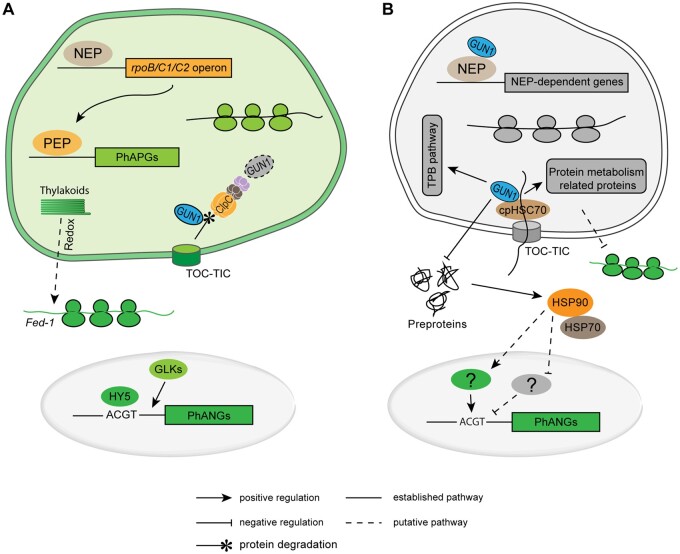Figure 2.
PGE-dependent retrograde control of nuclear gene expression. (A) In green tissues where chloroplast biogenesis is completed, PEP is responsible for the transcription of most plastid-encoded genes (including all PhAPGs: photosynthesis-associated plastid genes), while NEP mainly transcribes the rpoB/C1/C2 operon and a few genes containing only NEP promoters (e.g. accD, the only plastid-encoded gene involved in fatty acid metabolism). Positive regulators such as HY5 and GLKs activate PhANG transcription, the resulting mRNAs are translated in the cytosol and the protein products imported into chloroplasts through the TOC-TIC apparatus. GUN1 has no function at this stage and is rapidly degraded by the Clp protease upon import through the action of the chaperone ClpC1 (Wu et al., 2018). Chloroplast-derived redox signals related to PET activity regulate cytosolic mRNA stability by promoting the translation of specific mRNAs (e.g. Fed-1), thus preventing their ribonucleolytic degradation (Petracek et al., 1998). The light green ribosomes denote translation of PhAPGs in the chloroplast, the dark green ribosomes represent the translation of PhANGs in the cytosol. (B) When PGE is impaired (e.g. upon inhibition of translation with Lin), GUN1 interacts with cpHSC70-1, a motor protein of the TIC complex, and facilitates import of plastid-targeted proteins to maintain proteostasis of the plastid under stressful conditions (and preventing aberrant accumulation of preproteins in the cytosol). GUN1 clients (i.e. proteins whose import is GUN1-dependent) include proteins involved in various steps of plastid protein metabolism, and several enzymes of the TPB pathway (Wu et al., 2019a, 2019b). In the absence of GUN1, unimported preproteins accumulate in the cytosol, where their presence causes folding stress and triggers the accumulation of the cytosolic HSP90/HSP70 chaperone complex, which, in turn, derepresses PhANG expression. Thus, HSP90 activity is positively correlated with PhANG expression (Wu et al., 2019b), and may act by either activating positive or inhibiting negative transcriptional regulators in the nucleus. PhANGs and ribosomal proteins were shown to be regulated translationally (e.g. RBCS and LHCA4 are translationally repressed upon Lin treatment) and/or post-translationally either in a GUN1-dependent or independent manner (Wu et al., 2019a). GUN1 was also reported to be able to directly bind NEP to promote the expression of NEP-dependent genes (Tadini et al., 2020), although this possible function is likely independent of the gun phenotype of gun1 mutants. The gray ribosomes denote the translation of house-keeping genes in the plastid, the dark green ribosomes represent the translation of PhANGs in the cytosol.

